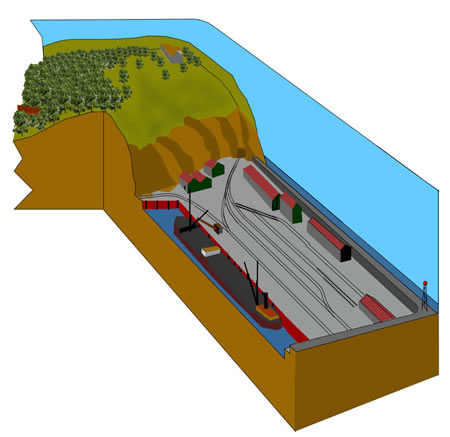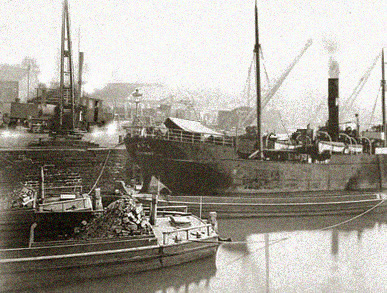|
building the baseboard of Glenthorne Harbour

conceptual drawing of the harbour
Glenthorne is not one of those cutesy harbours like
Clovelli but a hard working coal port, bringing in South Wales coal for the
area. It is dirty, covered with coal dust and not a listed building in sight!
Some commercial fishing comes from here and at times, general cargo is
offloaded. The part of the port depicted is the coal handling facility. It is a
reminder of the other side of the 1930s. If you were a Bertie Wooster, you would
be holed up at the Glenthorne Hotel having driven down from London in your
Lagonda. Life was not at all as pleasant for those working at the port.

The Glenthorne Harbour Authority also operates its
own collier, the Glenthorne Rose. Its name belies its 1896 origin and the fact
that it is now nothing but a rustbucket! It plies from Newport, South Wales to
Glenthorne and back and probably, by now, knows its way on its own!
Construction of the baseboard began in earnest in
early July 2008. The temporary end loop was dismantled and the plywood base was
adapted to fit inside of the new 'coffin'. The track base of the harbour branch
was fitted to continue with the 1:40 grade as far as the exit through the tunnel
cliff portal which brings the track down to the level of the harbour. Once happy
with the inter baseboard track joints, the track wiring was completed which
included cutting in two block sections for main line automation.

start of baseboard construction

The harbour branch track is laid and set in
ballast. I need to have the track totally rigid so that our Wobbler works! The
cutaway at the baseboard corner is to accommodate the curved backdrop.
The cross members under the port itself were then
fitted. This is when I had a bit of trouble with uphill water! The sea level was
1/2" higher than the East Lyn River on the next board. It all had to come apart
again and the baseboard sea level re-cut.

the completed baseboard being prepared for painting

the hidden loops under the cliff

|